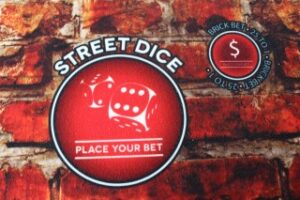Street Dice
Introduction
Street Dice is a dice game that debuted at the Downtown Grand casino in Las Vegas on May 16, 2014. It could loosely be described as a simplified version of craps, with just two bets and a maximum of four rolls to resolve a bet. At the Grand, the game is played outdoors with the dice cast inside a three-sided wood box, painted to look like an alley.

Rules
There are two bets only in Street Dice. Both are played with two ordinary dice.

In Street Dice, the Pass bet is placed before the “Set the Point” roll, which is akin to the come out roll in traditional craps. Here’s how the Pass bet outcomes are determined:
- If the Set the Point roll results in a 7, the Pass bet is a push.
- If the Set the Point roll results in an 11, the Pass bet wins even money.
- If the Set the Point roll results in a 2, 3, or 12, the Pass bet loses.
- Otherwise, the number rolled becomes the Point. The objective is to roll the Point again within three subsequent rolls without rolling a seven. The odds of winning depend on the Point and the roll number when it’s rolled again, as detailed in the pay table below.
- If a seven is rolled after the Set the Point roll or the player fails to roll the Point or a seven within three rolls (referred to as getting three strikes), the Pass bet loses.
These rules add excitement and strategic depth to Street Dice, creating anticipation and tension as players aim to roll specific numbers while avoiding the dreaded seven.
Pass Bet Pay Table
| Roll | Point | ||
|---|---|---|---|
| 4, 10 | 5, 9 | 6, 8 | |
| 1 | 5 to 1 | 4 to 1 | 3 to 1 |
| 2 | 4 to 1 | 3 to 1 | 2 to 1 |
| 3 | 3 to 1 | 2 to 1 | 1 to 1 |
Analysis
The following return table shows the probability and contribution to the return of all possible outcomes of the Pass bet. The lower right cell shows a house edge of 5.02%.
Pass Bet Return Table
| Event | Pays | Probability | Return |
|---|---|---|---|
| Set the Point roll 7 | 0 | 0.166667 | 0.000000 |
| Set the Point roll 11 | 1 | 0.055556 | 0.055556 |
| Set the Point roll 2, 3, 12 | -1 | 0.111111 | -0.111111 |
| Roll 1 — Point 4 or 10 | 5 | 0.013889 | 0.069444 |
| Roll 1 — Point 5 or 9 | 4 | 0.024691 | 0.098765 |
| Roll 1 — Point 6 or 8 | 3 | 0.038580 | 0.115741 |
| Roll 2 — Point 4 or 10 | 4 | 0.010417 | 0.041667 |
| Roll 2 — Point 5 or 9 | 3 | 0.017833 | 0.053498 |
| Roll 2 — Point 6 or 8 | 2 | 0.026792 | 0.053584 |
| Roll 3 — Point 4 or 10 | 3 | 0.007813 | 0.023438 |
| Roll 3 — Point 5 or 9 | 2 | 0.012879 | 0.025758 |
| Roll 3 — Point 6 or 8 | 1 | 0.018605 | 0.018605 |
| Seven out | -1 | 0.248114 | -0.248114 |
| Three strikes | -1 | 0.247054 | -0.247054 |
| Total | 1.000000 | -0.050223 |
The following return table shows the probability and contribution to the return of all possible outcomes of the Brick bet. The lower right cell shows a house edge of 6.27%.
Brick Bet Return Table
| Event | Pays | Probability | Return |
|---|---|---|---|
| Set the Point roll 7 or 11 | 0 | 0.222222 | 0.000000 |
| Set the Point roll 2, 3, 5, 9, 12 | -1 | 0.333333 | -0.333333 |
| Hard way win | 25 | 0.027502 | 0.687538 |
| Point made easy way | -1 | 0.088594 | -0.088594 |
| Seven out | -1 | 0.165009 | -0.165009 |
| Three strikes | -1 | 0.163340 | -0.163340 |
| Total | 1.000000 | -0.062738 |